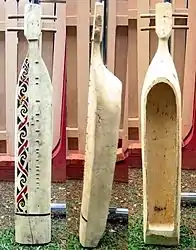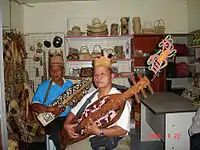Sapeh
The sape' (sampek, sampeh, sapek) is a traditional lute of many of the Orang Ulu or "upriver people", mainly the Kayan and Kenyah community who live in the longhouses that line the rivers of Central Borneo. Sapes are carved from a single bole of wood, with many modern instruments reaching over a metre in length.
 Front, side and back views of a Sape. | |
| String instrument | |
|---|---|
| Classification | String instrument |
| Hornbostel–Sachs classification | (Composite chordophone) |
| Developed | Borneo: Sarawak, Malaysia and Kalimantan, Indonesia |
| Related instruments | |
| Kutiyapi | |
Initially the sape was a fairly limited instrument with two strings and only three frets. Its use was restricted to a form of ritualistic music to induce trance. In the last century, the sape gradually became a social instrument to accompany dances or as a form of entertainment. Today, three, four or five-string instruments are used, with a range of more than three octaves.
Technically, the sape is a relatively simple instrument, with one string carrying the melody and the accompanying strings as rhythmic drones. In practice, the music is quite complex, with many ornamentations and thematic variations. There are two common modes, one for the men's longhouse dance and the other for the woman's longhouse dance. There also is a third rarely used mode. Sape music is usually inspired by dreams and there are over 35 traditional pieces with many variations. The overall repertoire is slowly increasing.
Sapes are still being made in Borneo, and modern innovations like electric sapes are common.
Image gallery
 Two men playing electric sapes.
Two men playing electric sapes. Sapeh player performing at the Central Market, Kuala Lumpur, Malaysia.
Sapeh player performing at the Central Market, Kuala Lumpur, Malaysia.
External links
- News article about a woman who learned to play the Sapeh.
- Video of musical duo playing both Malayan gambus (oud) and Sape. Sape part starts at 42 seconds.